Do you have a strategy? And what are your chances of executing it?
Is it based on penetrating insights and clear choices about direction, or is it endless analysis or superficial PowerPoint template-style presentations?
Is there a rich dialogue taking advantage of the full spectrum of knowledge and opportunities across the organisation, or is it a disconnected event; annually going through the motions resulting in a hollow promise of future growth?
Is it underpinned by the decision-making processes, organisational capability and joined-up behaviours to bring it to life, or is it an abstract and sterile exercise that is disconnected from, and distracts, day-to-day activity more than directs it?
Too many companies end-up on the wrong side of these extremes, destroying the value of any ‘strategy’ and wrecking their odds of making it happen anyway.
The StrataBridge Strategy Architecture is designed to overcome this problem and create the bridges between the strategy ‘3D’s’ – Development, Deployment and Delivery. Making your Ideal World your Real World
We believe that some structure is liberating; too much is constraining. The StrataBridge Strategy Architecture is a liberating structure. Respecting three natural laws – Change, Perspective and Entropy – the architecture reflects that there are no ‘one-size-fits-all’ solutions. When tailored to your application, the approach creates the guiding principles and addresses the strategic balances unique to your organisation. The five interconnected dimensions distinguish critical elements of bridging the gap between your real world and your ideal world – formulating strategy; keeping strategy alive, fresh and relevant; establishing the coherent actions to enact strategy; and cultivating the organisational capability to embed and continually sharpen this competitive edge.
At the heart of this structure is the recognition that any strategy needs to:
~ Contend with, and take advantage of, the volatility, uncertainty, complexity and ambiguity created by the world of constant change we live in;
~ Embrace multiple perspectives across, and beyond, our organisation and harness the insight and creativity that comes from this diversity of viewpoints, and;
~ Overcome entropy, leveraging the energy invested by focusing on the high-impact actions to accelerate and sustain results.
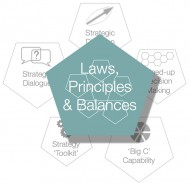 The application of these three laws – Change, Perspective and Entropy – will play-out differently in each organisation, giving rise to a unique set of guiding principles and embracing a range of strategic balances – both growth and productivity, both strategic moves and short-term results, both analysis and intuition, both commitment and agility, to name just a few. The effect of these forces and your unique response to them shapes how you approach and synthesise the other five dimensions.
The application of these three laws – Change, Perspective and Entropy – will play-out differently in each organisation, giving rise to a unique set of guiding principles and embracing a range of strategic balances – both growth and productivity, both strategic moves and short-term results, both analysis and intuition, both commitment and agility, to name just a few. The effect of these forces and your unique response to them shapes how you approach and synthesise the other five dimensions.
Most strategic plans tend to go ‘up and to the right’ – growth in its various forms – the only question is the gradient. The route between our current reality and the future we are creating is rarely such a simple straight line. The Law of Change teaches us that we cannot predict the future with absolute precision; Strategic Direction should follow the Keynesian principle that ‘it is better to be roughly right than precisely wrong’, focusing on the big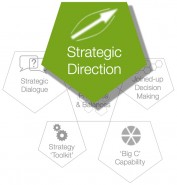 decisions about where and how to position ourselves for superior performance in the long-term and providing overarching direction for the many actions that will get us there. Strategic Direction is not only about setting this course of action but also establishing the boundaries, priorities and choices to enable course-correction along the way. Clarity of the choices, trade-offs and their consequences is critical to strategy development, focusing resources and energy on what we are going to do and where we are going to compete. Just as importantly, we need to be explicit about what we are not going to do and where we are not going to play; direction is about pointing the way to change and generating the creative tension that motivates and directs action. This provides a bridge to strategy deployment as these choices and consequences need to become more granular as they are communicated and acted upon through the organisation.
decisions about where and how to position ourselves for superior performance in the long-term and providing overarching direction for the many actions that will get us there. Strategic Direction is not only about setting this course of action but also establishing the boundaries, priorities and choices to enable course-correction along the way. Clarity of the choices, trade-offs and their consequences is critical to strategy development, focusing resources and energy on what we are going to do and where we are going to compete. Just as importantly, we need to be explicit about what we are not going to do and where we are not going to play; direction is about pointing the way to change and generating the creative tension that motivates and directs action. This provides a bridge to strategy deployment as these choices and consequences need to become more granular as they are communicated and acted upon through the organisation.
While some strategic decisions have a very long half-life, being revisited only infrequently, the context we are working in is constantly moving and increasingly dynamic – thanks to the Laws of Change, Perspective and Entropy. To keep pace with this changing environment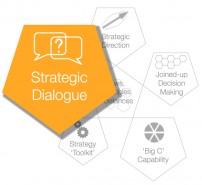 – both external and internal – and ensure our strategy remains alive, fresh and relevant, there needs to be an on-going Strategic Dialogue bringing together different perspectives from across, and beyond, our organisation. These structured questions and conversations, integrated into the processes and routines of the business, strengthen the bridge between strategy development, deployment and delivery and provide an invaluable platform for spotting emerging patterns and signals, developing organisational learning, innovation and engagement. While there may still be a place for the ‘set-piece’ – often stage-managed – annual strategy reviews, increasingly this on-going Strategic Dialogue will enable more frequent course-correction, keeping our strategy in-tune with the changing environment and the growth opportunities it brings.
– both external and internal – and ensure our strategy remains alive, fresh and relevant, there needs to be an on-going Strategic Dialogue bringing together different perspectives from across, and beyond, our organisation. These structured questions and conversations, integrated into the processes and routines of the business, strengthen the bridge between strategy development, deployment and delivery and provide an invaluable platform for spotting emerging patterns and signals, developing organisational learning, innovation and engagement. While there may still be a place for the ‘set-piece’ – often stage-managed – annual strategy reviews, increasingly this on-going Strategic Dialogue will enable more frequent course-correction, keeping our strategy in-tune with the changing environment and the growth opportunities it brings.
While Strategic Direction and Dialogue ensure we are making the big choices and keeping them in step with the broader context, Joined-up Decision-Making brings our strategy to life on a day-to-day basis. This synthesis of ‘hard’ and ‘soft’ aspects – the combination of free-flowing communication,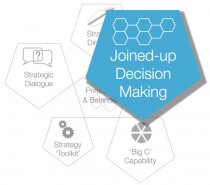 cross-functional alignment, activities, processes, routines, attitudes and behaviours – ensures clear decisions, accountability and action to make strategy happen, while operating within the boundaries set through our Strategic Direction. The monitoring and execution aspects that ensure delivery now are balanced by the scanning and planning mechanisms triggering decisions to secure performance through the short, medium and long-term. There are many techniques and approaches that operate in this space – S&OP, IBP, Balanced Scorecard, Strategy Maps, Hoshin Kanri, OGSM, Innovation Processes, to name a few. The trick is developing your unique combination of these to enable joined-up decision-making, while ensuring the ‘processes’ don’t get in the way of people executing your strategy.
cross-functional alignment, activities, processes, routines, attitudes and behaviours – ensures clear decisions, accountability and action to make strategy happen, while operating within the boundaries set through our Strategic Direction. The monitoring and execution aspects that ensure delivery now are balanced by the scanning and planning mechanisms triggering decisions to secure performance through the short, medium and long-term. There are many techniques and approaches that operate in this space – S&OP, IBP, Balanced Scorecard, Strategy Maps, Hoshin Kanri, OGSM, Innovation Processes, to name a few. The trick is developing your unique combination of these to enable joined-up decision-making, while ensuring the ‘processes’ don’t get in the way of people executing your strategy.
There are a vast range of ‘tools’ available – models, analyses, lenses, schema, directional examples, teachable points of view, etc – to support Strategy Development, Deployment & Delivery. The key is to avoid an over-dependence on the tools. Use these resources to provoke ideas,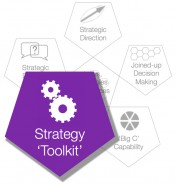 spot patterns, inform choices and trigger action; but the Toolkit is not a substitute for sharp insight, decisive choices and bold leadership. Unfortunately, many companies end-up having the ‘tail wagging the dog’, with the ‘tools’ becoming an end in themselves – endless analysis with no decisions, strategic plans that are no more than a collection of sterile ‘templates’, strategic ‘choices’ made with no insight and based on rote textbook thinking. To quote Henry David Thoreau, “We’ve become the tool of our tools”. Used properly, this Toolkit provokes our strategic dialogue, enables us to face the big and fundamental questions, and informs some critical choices. Individually each of the tools is ‘interesting’, but combined and used as part of a meaningful strategic dialogue, then they become really powerful.
spot patterns, inform choices and trigger action; but the Toolkit is not a substitute for sharp insight, decisive choices and bold leadership. Unfortunately, many companies end-up having the ‘tail wagging the dog’, with the ‘tools’ becoming an end in themselves – endless analysis with no decisions, strategic plans that are no more than a collection of sterile ‘templates’, strategic ‘choices’ made with no insight and based on rote textbook thinking. To quote Henry David Thoreau, “We’ve become the tool of our tools”. Used properly, this Toolkit provokes our strategic dialogue, enables us to face the big and fundamental questions, and informs some critical choices. Individually each of the tools is ‘interesting’, but combined and used as part of a meaningful strategic dialogue, then they become really powerful.
Bridging the gap between your Real World and your Ideal World is going to need the development of new and different capabilities. The term ‘capability’ is often used with a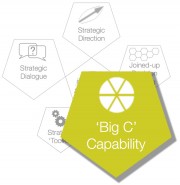 narrow definition, and at an individual level, frequently referring to personal ‘skills and competence’. While this is one dimension, to successfully develop, deploy and deliver strategy, we need to address broader organisational capability – for example leadership skills, culture, infrastructure, processes, organisational structure, measurements and incentives. The StrataBridge ‘Big C Capability’ model frames these ‘hard’ and ‘soft’ aspects– at the individual, team, leadership and organisational levels – which, defined by our Strategic Direction, ensure we are developing the organisational ‘bench-strength’ to bridge the gap between our Real World and Ideal World; accelerating results, building resilience and ensuring sustainability.
narrow definition, and at an individual level, frequently referring to personal ‘skills and competence’. While this is one dimension, to successfully develop, deploy and deliver strategy, we need to address broader organisational capability – for example leadership skills, culture, infrastructure, processes, organisational structure, measurements and incentives. The StrataBridge ‘Big C Capability’ model frames these ‘hard’ and ‘soft’ aspects– at the individual, team, leadership and organisational levels – which, defined by our Strategic Direction, ensure we are developing the organisational ‘bench-strength’ to bridge the gap between our Real World and Ideal World; accelerating results, building resilience and ensuring sustainability.
Put simply, the strategy architecture brings together some common-sense steps – know where you’re going; keep talking about it, use whatever resources available to make it relevant, make it happen, and make sure the organisation can keep doing it better than the competition. But strategy is about asking tough questions, and inject the ‘complication’ – and creativity – of it being a human-centred process, and it means grappling with these questions becomes a rich, multifaceted and nuanced process. While the StrataBridge Strategy Architecture aims to offer some simplicity out of this complexity, over-simplifying is a risk – we should heed Albert Einstein’s warning: “For every complex question there is a simple and wrong solution”.
Like any creative process, strategy development, deployment and delivery are messy and iterative. The dimensions of the StrataBridge Strategy Architecture are overlapping frames and lenses to look at the subject through. The value comes from the interaction, interdependence and creative tension this creates. Like strategy itself, the magic is in the mix. This is a way of thinking, not a formulaic, mechanical, templatised ‘procedure’.
So, back to the opening questions: Do you have a strategy? And what are your chances of executing it? Connect the Strategy 3D’s – Development, Deployment and Delivery. Make your Ideal World your Real World.
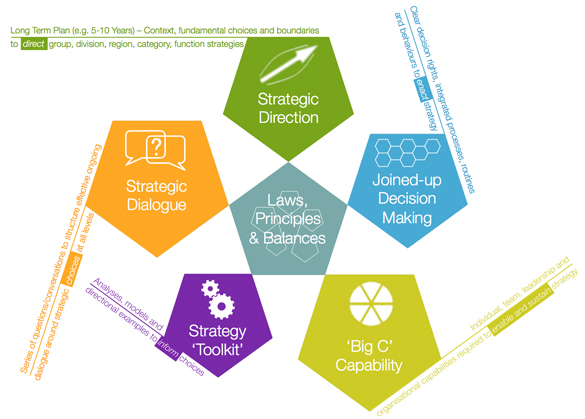
Comments (4)
Comments are closed.